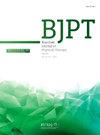Translation, cross-cultural adaptation, and psychometric properties of the Spanish version of the dysfunctional voiding score symptoms (DVSS-Sp) questionnaire in a pediatric chilean sample
IF 3.2
3区 医学
Q1 ORTHOPEDICS
引用次数: 0
Abstract
Background
The Dysfunctional Voiding Score Symptoms (DVSS) questionnaire is commonly used to evaluate dysfunctional voiding and incontinence (DVI).
Objectives
To translate and culturally adapt the DVSS questionnaire into Spanish (DVSS-Sp) in pediatric population and to assess its psychometric properties.
Methods
The process of translation and cultural validation were done. To obtain evidence of validity and reliability, we evaluated the fit of different factor models and calculated internal consistency coefficients. Also, the diagnostic capacity of the DVSS-Sp scale was assessed through a logistic regression analysis and a receiver operating characteristic (ROC) curve. Accordingly, a total sample of 248 participants was recruited (204 with a diagnosis of DVIs and 44 with no medical problems).
Results
The cross-cultural adaptation showed an adequate correspondence with the original version. The DVSS-Sp was configured with 2 factors: Overactive Bladder (OB) symptoms (items 1, 2, 6, and 7) and Dysfunctional Elimination (DE) symptoms (items 3, 4, 8, and 9), showing excellent goodness-of-fit indices. The relationship between the factors OB and DE was low. The reliability of the OB factor was α = 0.68, ω = 0.71, and the DE factor was α = 0.56, ω = 0.57. A logistic regression analysis suggests a good diagnostic capacity of the DVSS-Sp scale. Additionally, ROC analysis showed a cut-off score of 3.5 on the DVSS-Sp scale, where the specificity was 0.907, and the sensitivity was 0.636.
Conclusion
The results of this study support the use of the DVSS-Sp for assessing DVIs in Spanish-speaking children.
西班牙语版排尿功能障碍症状(DVSS-Sp)问卷在智利儿科样本中的翻译、跨文化适应性和心理计量特性
背景排尿功能障碍评分症状(DVSS)问卷常用于评估排尿功能障碍和尿失禁(DVI)。目的将DVSS问卷翻译成西班牙语(DVSS-Sp)并进行文化适应性调整,评估其在儿科人群中的心理测量学特性。为了获得有效性和可靠性的证据,我们评估了不同因子模型的拟合度,并计算了内部一致性系数。此外,我们还通过逻辑回归分析和接收者操作特征曲线(ROC)评估了 DVSS-Sp 量表的诊断能力。因此,共招募了 248 名参与者(其中 204 人被诊断为 DVIs,44 人无任何医疗问题)。DVSS-Sp 包含 2 个因子:膀胱过度活动症(OB)症状(项目 1、2、6 和 7)和排泄功能障碍(DE)症状(项目 3、4、8 和 9)显示出极佳的拟合指数。OB因子和DE因子之间的关系较低。OB 因子的可靠性为 α = 0.68,ω = 0.71,DE 因子的可靠性为 α = 0.56,ω = 0.57。逻辑回归分析表明,DVSS-Sp量表具有良好的诊断能力。此外,ROC 分析显示,DVSS-Sp 量表的临界值为 3.5 分,特异性为 0.907,灵敏度为 0.636。
本文章由计算机程序翻译,如有差异,请以英文原文为准。
求助全文
约1分钟内获得全文
求助全文
来源期刊
CiteScore
6.10
自引率
8.80%
发文量
53
审稿时长
74 days
期刊介绍:
The Brazilian Journal of Physical Therapy (BJPT) is the official publication of the Brazilian Society of Physical Therapy Research and Graduate Studies (ABRAPG-Ft). It publishes original research articles on topics related to the areas of physical therapy and rehabilitation sciences, including clinical, basic or applied studies on the assessment, prevention, and treatment of movement disorders.

 求助内容:
求助内容: 应助结果提醒方式:
应助结果提醒方式:


